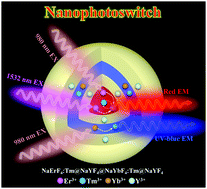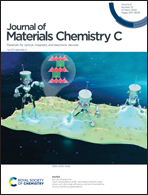A novel upconversion core–multishell nanoplatform for a highly efficient photoswitch†
Abstract
Currently, the red-to-UV-blue (R/U) ratio in the existing upconversion (UC) nanophotoswitches is too low to effectively realize real-time monitoring/imaging during the photodynamic therapy (PDT) process. Besides, the imaging depth is quite limited by using the NIR-I excitation (NIR-I = the first near-infrared biological window: 700–1000 nm), which cannot effectively determine the location of cancer cells before the induction of PDT. In this work, a novel NaErF4:0.5%Tm@NaYF4@NaYbF4:0.2%Tm@NaYF4 UC core–multishell nanophotoswitch is presented. For this Nd3+-free nanophotoswitch design, on the premise of ensuring the optimum intensity of UV-blue emission, red UC emission intensity is significantly enhanced under dual-NIR excitations. When the switch is turned off (before the induction of PDT), UV-blue emissions are turned off and red emission is left for real-time imaging under 1532 nm NIR-II excitation (NIR-II = the second near-infrared biological window: 1000–1700 nm), due to which the location of cancer cells can be effectively determined. When the switch is turned on, UV-blue and red emissions are simultaneously turned on with a high R/U ratio for PDT and real-time monitoring/imaging under 980 nm NIR-I excitation. This new type of UC nanophotoswitch can not only realize real-time imaging, but also simultaneously realize PDT and real-time monitoring/imaging, demonstrating the distinct advantages in bioapplications.



 Please wait while we load your content...
Please wait while we load your content...